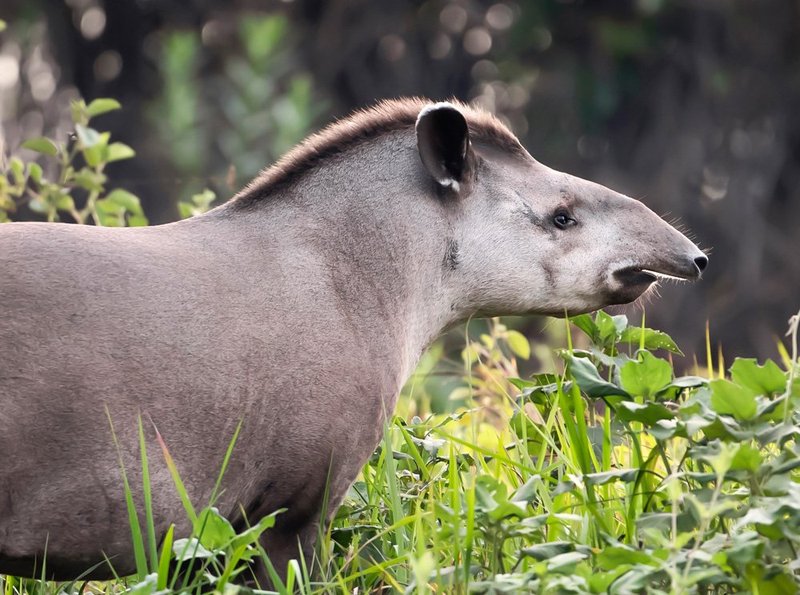
You might be wondering why this somewhat unusual animal is so important in cultural narratives. Well, the Brazilian tapir has been a symbol in local folklore, representing various themes such as nature, balance, and survival. Through stories passed down generations, it has become a character that reflects the relationship between humans, animals, and the environment. Let’s dive into the ways the Brazilian tapir is portrayed in culture and folklore, showing how it resonates with people and their values.
The Brazilian Tapir: A Quick Introduction
Before we get into its cultural significance, let’s take a moment to understand what a Brazilian tapir actually is. These large, herbivorous mammals are often found in the lush rainforests and wetlands of Brazil. They can weigh between 500 to 700 pounds and are known for their unique appearance—short legs, a rounded body, and a distinctive trunk-like snout. They are excellent swimmers, and their diet primarily consists of leaves, fruit, and aquatic vegetation.
The Brazilian tapir is not just a solitary creature; it plays a vital role in its ecosystem. As it munches away on foliage, it helps to disperse the seeds of various plants. This is crucial for maintaining the health of the rainforest. You might say that, in its own way, the tapir serves as a gardener of the forest, nurturing the environment while it goes about its day.
Tapirs in Indigenous Folklore
Many indigenous cultures in Brazil have woven the Brazilian tapir into their folklore. For instance, the Tupi-Guarani people have stories that revolve around the tapir as a creature of strength and resilience. In some legends, the tapir is depicted as a guardian of the forest, protecting it from harm. These tales often serve as a reminder of the need to respect nature and the creatures that inhabit it.
You might find it interesting that in some stories, the tapir is also associated with creation myths. For example, one legend tells of a giant tapir that helped shape the mountains and rivers. This emphasizes the idea that every creature, no matter how big or small, has a role in the world’s creation and balance.
Tapirs in Contemporary Brazilian Culture
Fast forward to today, and the Brazilian tapir still holds cultural significance. In modern Brazilian art, literature, and music, the tapir appears as a symbol of the wild, untamed beauty of the Amazon. Artists often use the tapir to represent Brazil’s rich biodiversity and the importance of conservation efforts. For instance, in visual arts, you might see vibrant paintings of tapirs surrounded by lush greenery, depicting their critical role in the ecosystem.
Moreover, the tapir’s plight as a vulnerable species has sparked conversations about environmental awareness. With habitat loss and hunting threatening its existence, many advocacy groups use the tapir as a mascot for conservation campaigns. This not only raises awareness but also connects the past folklore with present-day efforts to protect the environment.
Symbolism of the Tapir in Culture
The Brazilian tapir embodies a variety of symbolic meanings across different cultures. It often represents balance and harmony within nature. In many stories, the tapir’s gentle nature contrasts sharply with the more aggressive creatures of the jungle. This duality serves as a metaphor for the balance of life; a reminder that strength doesn’t always come from aggression.
Furthermore, some cultures view the tapir as a symbol of perseverance. Its ability to navigate through dense forests and muddy waters showcases resilience and adaptability. This can be inspiring for many people facing challenges in their lives, reminding them that, like the tapir, they can overcome obstacles.
Tapirs in Literature and Media
In literature, the Brazilian tapir has found its way into various stories aimed at children and adults alike. You might come across children’s books that feature the tapir as a friendly character who embarks on adventurous journeys through the rainforest. These tales often aim to teach young readers about the importance of nature and the role of wildlife in our ecosystem.
In more serious literary contexts, authors may use the tapir as a metaphor for broader themes, such as the conflict between modernization and nature conservation. This allows readers to engage with important societal issues while appreciating the unique characteristics of this animal.
Conservation and the Tapir’s Role
As fun and dynamic as the Brazilian tapir is when portrayed in stories, it is essential to acknowledge the real-world challenges it faces. The tapir is considered a vulnerable species, primarily due to habitat loss and hunting. Many organizations focus on conservation efforts that aim to protect the tapir and its habitat, ensuring that this important creature remains a part of Brazil’s natural heritage.
By incorporating the tapir into conservation narratives, these organizations reinforce the connection between cultural identity and environmental stewardship. When people learn about the tapir’s significance in folklore, they may feel a stronger urge to protect it. This creates a lovely loop—cultural appreciation leading to real-world conservation efforts.
The Brazilian tapir, with its unique traits and intriguing place in culture and folklore, truly is a symbol of nature’s beauty and fragility. From indigenous tales portraying it as a guardian of the forest to contemporary literature and art that highlight its role in biodiversity, the tapir resonates deeply with themes of resilience, balance, and environmental awareness.
As we reflect on the stories and symbols associated with this remarkable creature, it’s clear that the Brazilian tapir is more than just an animal—it’s a representation of our relationship with nature. By understanding and appreciating its cultural significance, we can foster a deeper connection to the environment we share. So, next time you think about the tapir, remember that this gentle giant carries with it a legacy that deserves to be honored and protected.

